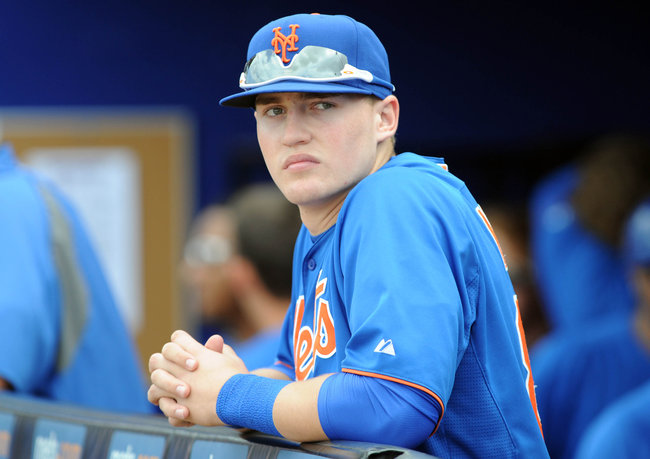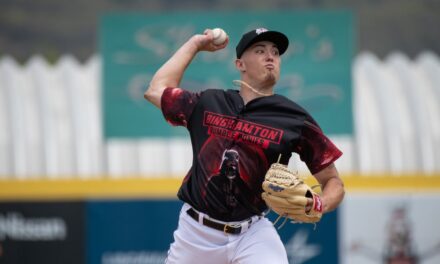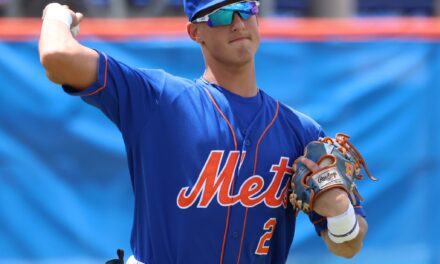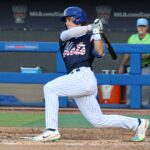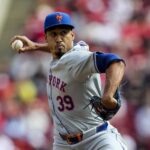Since Sandy Alderson took over in 2010, his main focus has been rebuilding a depleted farm system. He has done a pretty good job of it by drafting very young players with impressive, raw tools that need polish in Gavin Cecchini, Brandon Nimmo, and Dominic Smith, and adding some more promising names via trade in Zack Wheeler, Noah Syndergaard, Travis d’Arnaud, Dilson Herrera, and Vic Black.
Developing prospects is becoming more and more crucial to maintaining a successful major league organization due to the inflation of free agent prices. Teams are signing their young phenoms through their prime which drives up the price for the thin market of reliable players available in free agency. The best way to have these promising young players on your team is by drafting, trading for, and developing them yourself.
The Mets have a middle-of-the-pack farm system rich in pitching but lacking in offense. However, at the end of the day, prospects are simply prospects until they prove their worth. The Mets have some very promising names, but none without flaws. Let’s take a look at some of these names and the areas in which they must improve.
Gavin Cecchini, SS
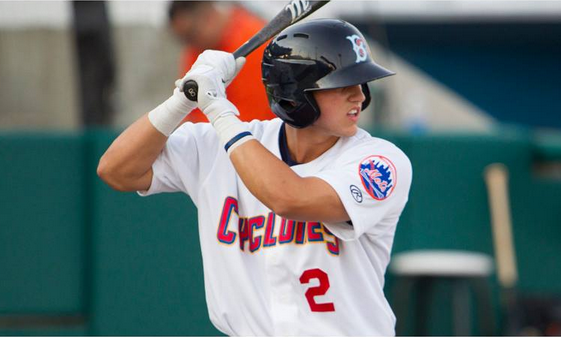 I think Gavin Cecchini’s ceiling has been somewhat underrated by some scouts and even by people in the Mets system who usually tend to overrate their prospects. At the time, he wasn’t the most exciting first round pick but the Mets drafted him because his already impressive floor provided somewhat of a safety net. There’s not much to worry about defensively here as Cecchini has been described as having outstanding instincts, decent range, and an average arm which is a potent enough skillset to stick at shortstop for the long term. Offensively, Cecchini will always have below average power so his hit tool is what will determine if he can be a top of the order (potentially leadoff) hitter or a bottom of the order, defensive-first shortstop. In Brooklyn last season, Cecchini had a nice little hitting streak going for a while (mostly singles), producing a modest .273 average but did not show a very patient approach (.319 OBP with 14 BB in 212 PA). I believe he has the speed and ability to steal around 20 bases per season, profiling nicely as a leadoff hitter. However, in order to fulfill this projection, Cecchini must show a more selective approach so he gets better pitches to hit. This will allow him to draw a good amount of walks and spray line drives all over the field. Cecchini is the type of player that, if his potential is achieved, will have no trouble succeeding at Citi Field. Because of the spacious outfield, line drives have a tendency to fall in front of outfielders and find the gaps. If he can become this type of hitter, he should have no trouble batting in the vicinity of .300 with a solid OBP and plenty of doubles and triples. However, he must show improvement on last season’s numbers, particularly his walks and line drive rate. If he continues to struggle in these areas, he may be more suited to bat in front of the pitcher.
I think Gavin Cecchini’s ceiling has been somewhat underrated by some scouts and even by people in the Mets system who usually tend to overrate their prospects. At the time, he wasn’t the most exciting first round pick but the Mets drafted him because his already impressive floor provided somewhat of a safety net. There’s not much to worry about defensively here as Cecchini has been described as having outstanding instincts, decent range, and an average arm which is a potent enough skillset to stick at shortstop for the long term. Offensively, Cecchini will always have below average power so his hit tool is what will determine if he can be a top of the order (potentially leadoff) hitter or a bottom of the order, defensive-first shortstop. In Brooklyn last season, Cecchini had a nice little hitting streak going for a while (mostly singles), producing a modest .273 average but did not show a very patient approach (.319 OBP with 14 BB in 212 PA). I believe he has the speed and ability to steal around 20 bases per season, profiling nicely as a leadoff hitter. However, in order to fulfill this projection, Cecchini must show a more selective approach so he gets better pitches to hit. This will allow him to draw a good amount of walks and spray line drives all over the field. Cecchini is the type of player that, if his potential is achieved, will have no trouble succeeding at Citi Field. Because of the spacious outfield, line drives have a tendency to fall in front of outfielders and find the gaps. If he can become this type of hitter, he should have no trouble batting in the vicinity of .300 with a solid OBP and plenty of doubles and triples. However, he must show improvement on last season’s numbers, particularly his walks and line drive rate. If he continues to struggle in these areas, he may be more suited to bat in front of the pitcher.
Gavin Cecchini 2013 Top Prospect Video (MLB.com)
Travis d’Arnaud, C
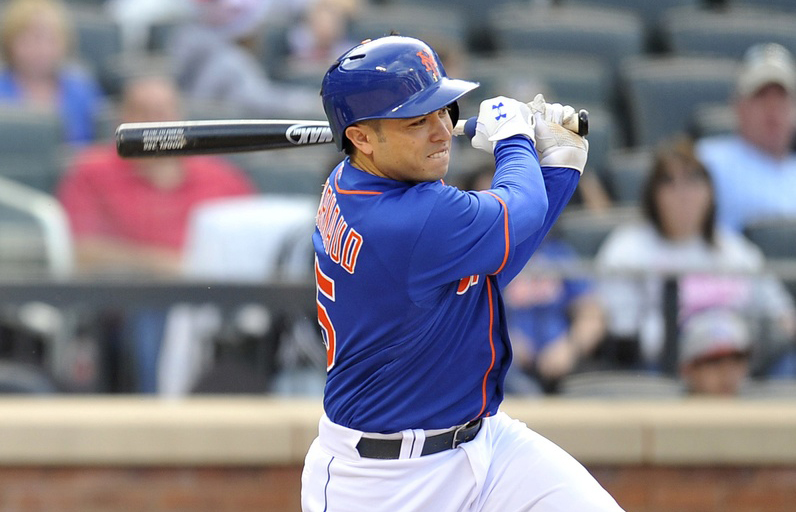 Travis d’Arnaud’s ability to stay healthy was once again questioned this year when he took a foul ball off the foot and ended up in a walking boot for a few months. This was not nearly as concerning to me as the knee and back problems he experienced in previous seasons, which can be detrimental to a catcher’s ability to stay on the field. Catchers take a beating on the daily which puts any of them at risk for a freak injury so the fractured foot was more of bad luck than anything else. However, that does not completely excuse him of his injury troubles. TDA has to prove the knee and back problems that popped up earlier in his professional career are not a concern anymore. Barring any random injuries, he should be able to play in around 120-130 games. If he can do this, I think he will be just fine. d’Arnaud also has something to prove with the bat though. You could make excuses for him and say that he struggled after his call up last season due to rust from missing a few months or that he was concentrating on his defense. I, however, am not going to let him get off that easily. It may have just been anxiousness but he needs to cut down on his strikeouts by being more selective at the plate. He has a sweet swing, the strength to hit around 20 bombs per season as well as hit for a high average. That combined with solid defense makes for a pretty rare, Buster Posey-esque specimen behind the plate. If d’Arnaud can stay on the field and display the hitting ability that was advertised when he came over in the RA Dickey deal, then we may have an All Star on our hands.
Travis d’Arnaud’s ability to stay healthy was once again questioned this year when he took a foul ball off the foot and ended up in a walking boot for a few months. This was not nearly as concerning to me as the knee and back problems he experienced in previous seasons, which can be detrimental to a catcher’s ability to stay on the field. Catchers take a beating on the daily which puts any of them at risk for a freak injury so the fractured foot was more of bad luck than anything else. However, that does not completely excuse him of his injury troubles. TDA has to prove the knee and back problems that popped up earlier in his professional career are not a concern anymore. Barring any random injuries, he should be able to play in around 120-130 games. If he can do this, I think he will be just fine. d’Arnaud also has something to prove with the bat though. You could make excuses for him and say that he struggled after his call up last season due to rust from missing a few months or that he was concentrating on his defense. I, however, am not going to let him get off that easily. It may have just been anxiousness but he needs to cut down on his strikeouts by being more selective at the plate. He has a sweet swing, the strength to hit around 20 bombs per season as well as hit for a high average. That combined with solid defense makes for a pretty rare, Buster Posey-esque specimen behind the plate. If d’Arnaud can stay on the field and display the hitting ability that was advertised when he came over in the RA Dickey deal, then we may have an All Star on our hands.
Travis d’Arnaud 2013 Top Prospect Video (MLB.com)
Jeurys Familia, RHP
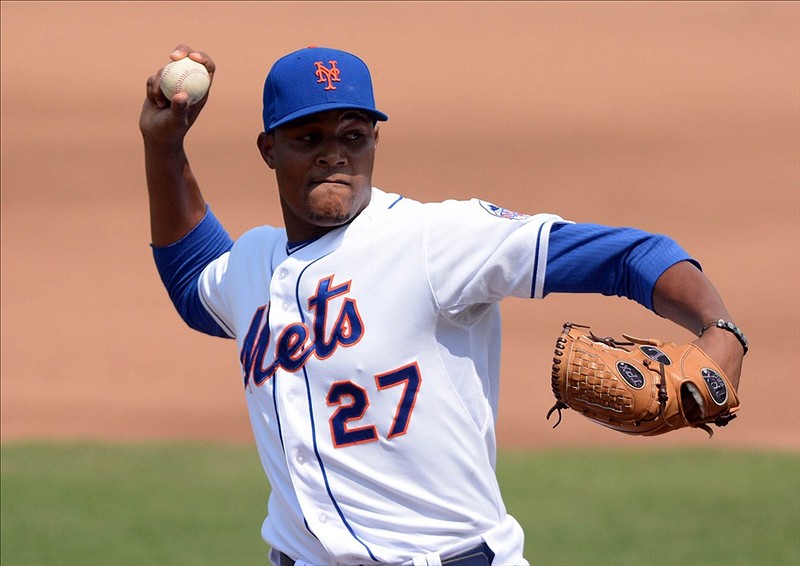 Jeurys Familia has an electric fastball, there’s no doubt about that. He consistently throws it at 95 mph with some sink and can touch triple digits on occasion. He also showcases an above average slider and a fringe average changeup. With refinement to his secondary pitches, Familia has the potential to be an elite closer; an asset that certainly does not grow on trees (ask the 2007 Mets bullpen). However, there is a catch. Familia walks everyone and their mothers. A reliever who does not throw strikes is virtually useless. Teams can simply not afford to give free passes late in ball games, especially the 9th inning. Familia has to prove that he can hit his targets with his fastball and secondary pitches. If he shows even an inkling of an ability to throw strikes, he’ll be an effective reliever with a high strikeout rate.
Jeurys Familia has an electric fastball, there’s no doubt about that. He consistently throws it at 95 mph with some sink and can touch triple digits on occasion. He also showcases an above average slider and a fringe average changeup. With refinement to his secondary pitches, Familia has the potential to be an elite closer; an asset that certainly does not grow on trees (ask the 2007 Mets bullpen). However, there is a catch. Familia walks everyone and their mothers. A reliever who does not throw strikes is virtually useless. Teams can simply not afford to give free passes late in ball games, especially the 9th inning. Familia has to prove that he can hit his targets with his fastball and secondary pitches. If he shows even an inkling of an ability to throw strikes, he’ll be an effective reliever with a high strikeout rate.
Jeurys Familia 2013 Top Prospect Video (MLB.com)
Wilmer Flores, INF
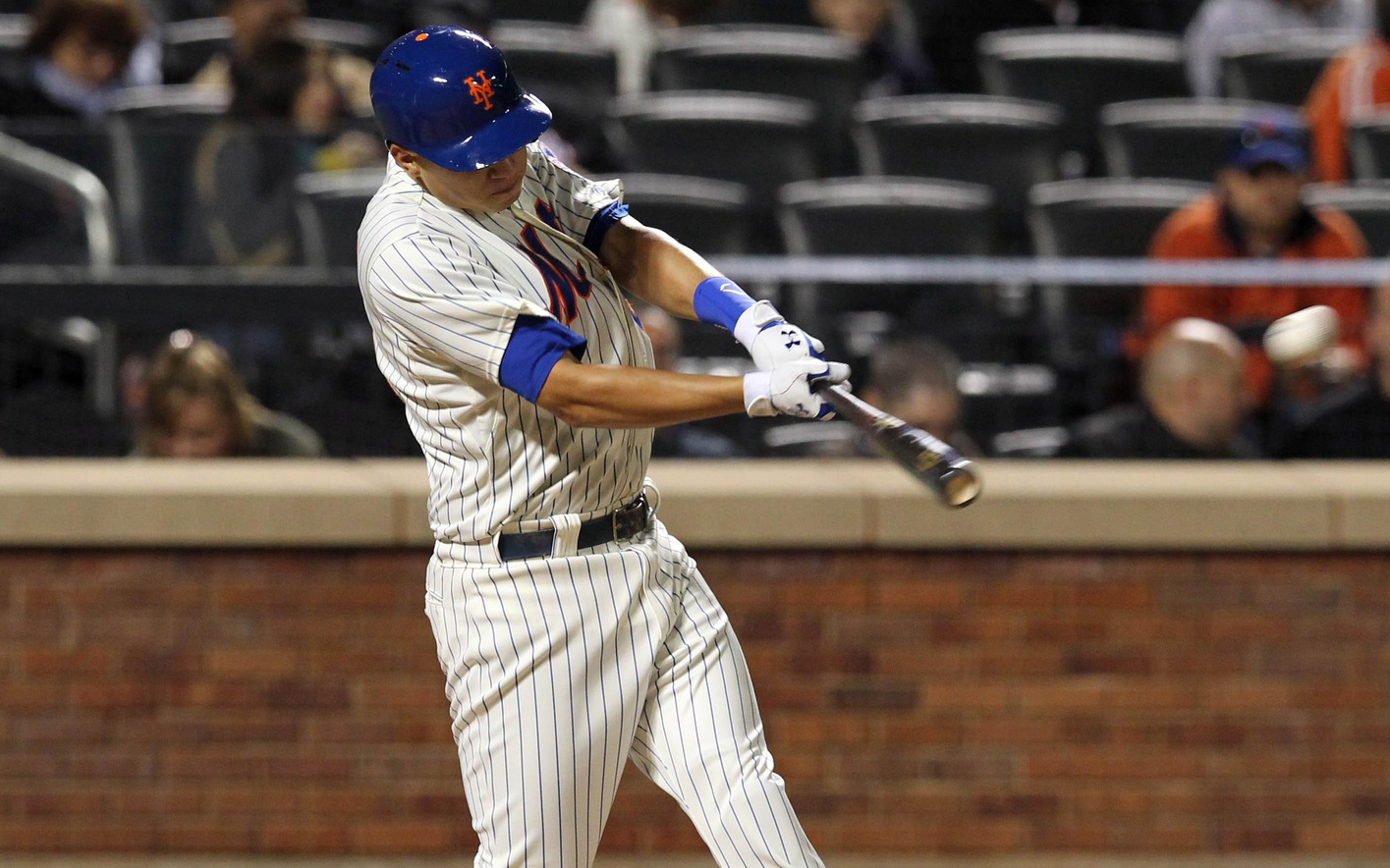 Ah, Wilmer Flores.. the positionless wonder. Comparisons to Miguel Cabrera earlier in his career quickly came back down to earth. They do have one thing in common however, they can’t play defense. Despite him originating as a shortstop, Flores is slow-footed with minimal range, limiting him to a corner infield position at the moment. He is trying hard to improve his quickness and speed to possibly add second base to his repertoire but I just don’t see that happening. He’s a tall kid, standing at 6’3” and weighing in at 190 pounds. Efforts to fit in at second are meaningless to me because he is going to fill out and become even slower sooner or later. He might be able to fit in at third base because of his strong arm but I don’t think I need to get into why that won’t work for the Mets. Flores’ status as a major leaguer depends entirely on how he hits. Bad ankles or not, he did not impress after being called up. In my mind, the Mets have two options on how to deal with Flores. If he shows he can hit in the bigs similar to how he did in AAA (.321/.357/.531 in 107 games) and continue working on his speed and quickness, he could build up nice trade value as a major league third basemen. The second option involves completely revamping his approach at the plate. As it stands, Wilmer is a line drive hitter who should be able to hit for a pretty good average because of his ability to cover all parts of the plate with his swing. He has the frame, however, to hit for power once he fills out. If he starts the season in AAA and revamps his swing, he could become a decent power hitter. He may strike out more and hit for a lower average but if he could hit 25 home runs per season, he can play first base for the Mets. Flores’ main focus, nonetheless, should be to first prove he can be a successful hitter in the major leagues.
Ah, Wilmer Flores.. the positionless wonder. Comparisons to Miguel Cabrera earlier in his career quickly came back down to earth. They do have one thing in common however, they can’t play defense. Despite him originating as a shortstop, Flores is slow-footed with minimal range, limiting him to a corner infield position at the moment. He is trying hard to improve his quickness and speed to possibly add second base to his repertoire but I just don’t see that happening. He’s a tall kid, standing at 6’3” and weighing in at 190 pounds. Efforts to fit in at second are meaningless to me because he is going to fill out and become even slower sooner or later. He might be able to fit in at third base because of his strong arm but I don’t think I need to get into why that won’t work for the Mets. Flores’ status as a major leaguer depends entirely on how he hits. Bad ankles or not, he did not impress after being called up. In my mind, the Mets have two options on how to deal with Flores. If he shows he can hit in the bigs similar to how he did in AAA (.321/.357/.531 in 107 games) and continue working on his speed and quickness, he could build up nice trade value as a major league third basemen. The second option involves completely revamping his approach at the plate. As it stands, Wilmer is a line drive hitter who should be able to hit for a pretty good average because of his ability to cover all parts of the plate with his swing. He has the frame, however, to hit for power once he fills out. If he starts the season in AAA and revamps his swing, he could become a decent power hitter. He may strike out more and hit for a lower average but if he could hit 25 home runs per season, he can play first base for the Mets. Flores’ main focus, nonetheless, should be to first prove he can be a successful hitter in the major leagues.
Wilmer Flores 2013 Top Prospect Video (MLB.com)
Jenrry Mejia, RHP
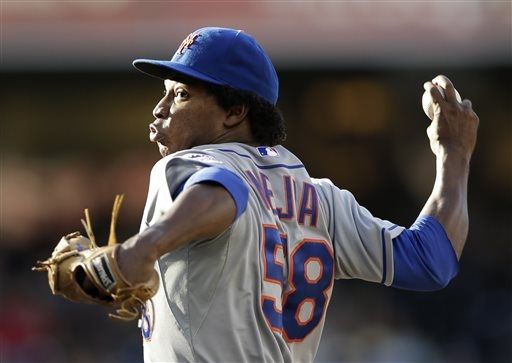 Jenrry Mejia is an intriguing case. He has been described by prospect guru Keith Law as a pitcher with top of the rotation stuff. This must mean something because Law is notorious for hating on prospects in the Mets organization. Previous to his Tommy John surgery in 2011, all he really had was a good fastball and an average slider and changeup but he was the Mets’ best pitching prospect at the time. When he came up last year with a new uniform number and an exceptional Jheri curl, he [literally] looked like an entirely different pitcher. He showed the same 92-94 mph fastball, this time packaged with a devastating slider and solid changeup. Not to mention his control was pinpoint as well. I became very excited watching Mejia pitch last season. He reminds me a lot of Johnny Cueto and I truly believe he can be a force in the rotation along with Harvey, Wheeler, and Syndergaard IF he stays healthy. He’s never thrown more than 108 innings in a season which is a concern if he’s destined to become a starter. Frontline starters nowadays are relied on for at least 200 innings per season. Mejia is still just 23 years old (around a year younger than Matt Harvey) so he has time to get his act together. He simply has to prove that the stuff he displayed last year was legitimate and that he can provide it all year long. If he does that, the Mets’ pitching depth becomes that much deeper. He very well could become extremely valuable trade bait to acquire a true impact hitter next season.
Jenrry Mejia is an intriguing case. He has been described by prospect guru Keith Law as a pitcher with top of the rotation stuff. This must mean something because Law is notorious for hating on prospects in the Mets organization. Previous to his Tommy John surgery in 2011, all he really had was a good fastball and an average slider and changeup but he was the Mets’ best pitching prospect at the time. When he came up last year with a new uniform number and an exceptional Jheri curl, he [literally] looked like an entirely different pitcher. He showed the same 92-94 mph fastball, this time packaged with a devastating slider and solid changeup. Not to mention his control was pinpoint as well. I became very excited watching Mejia pitch last season. He reminds me a lot of Johnny Cueto and I truly believe he can be a force in the rotation along with Harvey, Wheeler, and Syndergaard IF he stays healthy. He’s never thrown more than 108 innings in a season which is a concern if he’s destined to become a starter. Frontline starters nowadays are relied on for at least 200 innings per season. Mejia is still just 23 years old (around a year younger than Matt Harvey) so he has time to get his act together. He simply has to prove that the stuff he displayed last year was legitimate and that he can provide it all year long. If he does that, the Mets’ pitching depth becomes that much deeper. He very well could become extremely valuable trade bait to acquire a true impact hitter next season.
Brandon Nimmo, OF
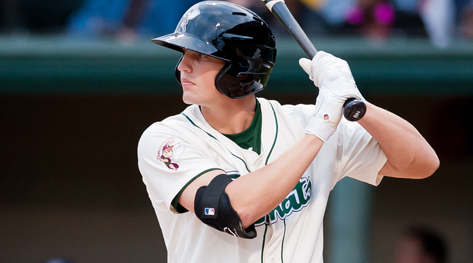 Brandon Nimmo is easily my favorite Mets hitting prospect when it comes to his ceiling because he shows true five tool potential. He is described as having solid average speed with a solid average arm so he may not be able to stick in center field long term. With that being said, Nimmo’s value in a corner outfield spot will largely depend on the kind of power he produces. I may be the only person to say this but I think he is capable of hitting 25-30 home runs at his peak. He’s got the body type for it and he’s already showed great plate discipline which is impressive for someone with a limited amount of experience. His main problem is pitch recognition which is shown through his 131 strikeouts in 395 AB’s (33%). He absolutely needs to improve significantly in this area to tap into that raw power. Even with the abundance of strikeouts, Nimmo still batted .273 (although with only a .359 slugging %). This leads me to believe if Nimmo can see the baseball better out of the pitcher’s hand he could sustain at least a .280 average with plenty of home runs and doubles (maybe even a decent amount of stolen bases sprinkled in), while providing above average defense in left field. He still has a very long path to accomplish this but with hard work it is possible. His power numbers last year should not be a cause for concern just yet as Savannah is brutal on lefty power hitters. I would be fairly concerned if he struggles with pitch recognition mightily again this year but hopefully some improvement is on the horizon.
Brandon Nimmo is easily my favorite Mets hitting prospect when it comes to his ceiling because he shows true five tool potential. He is described as having solid average speed with a solid average arm so he may not be able to stick in center field long term. With that being said, Nimmo’s value in a corner outfield spot will largely depend on the kind of power he produces. I may be the only person to say this but I think he is capable of hitting 25-30 home runs at his peak. He’s got the body type for it and he’s already showed great plate discipline which is impressive for someone with a limited amount of experience. His main problem is pitch recognition which is shown through his 131 strikeouts in 395 AB’s (33%). He absolutely needs to improve significantly in this area to tap into that raw power. Even with the abundance of strikeouts, Nimmo still batted .273 (although with only a .359 slugging %). This leads me to believe if Nimmo can see the baseball better out of the pitcher’s hand he could sustain at least a .280 average with plenty of home runs and doubles (maybe even a decent amount of stolen bases sprinkled in), while providing above average defense in left field. He still has a very long path to accomplish this but with hard work it is possible. His power numbers last year should not be a cause for concern just yet as Savannah is brutal on lefty power hitters. I would be fairly concerned if he struggles with pitch recognition mightily again this year but hopefully some improvement is on the horizon.
Brandon Nimmo 2013 Top Prospect Video (MLB.com)
Cesar Puello, OF
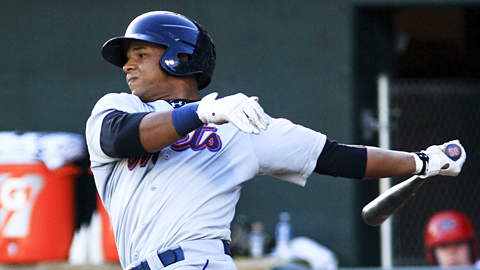 Cesar Puello is another prospect who shows flashes of five tool potential. However, his gaudy numbers in AA last season were taken with a grain of salt by most scouts due to his link to Biogenesis. Keith Law, for example, only sees Puello as an extra outfielder. Regardless of what scouts think, Puello has amazing potential from a raw tools perspective. He’s an above average fielder and runner with a cannon of an arm so it sounds like he’s best suited for right field. He has good bat speed and considerable raw power but his approach needs some work as he tends to be overly aggressive. This is probably why Law was so low on him. If pitchers can exploit his aggressive approach and get him to swing at pitches out of the strike zone, he will not be a very effective hitter. If he can improve in this area it’s reasonable to expect 20-25 homers and 20-25 steals from him with a solid average. In my opinion, he needs at least one more full season in the minors to work on his overall approach. There’s speculation that he could be brought up sometime in 2014 but I think that would be somewhat premature. He needs to show that his numbers last season were not a fluke by repeating a similar performance this season in AAA. If he can do that while also showing an ability to work counts and get pitches to hit, I’ll be okay with a September call-up.
Cesar Puello is another prospect who shows flashes of five tool potential. However, his gaudy numbers in AA last season were taken with a grain of salt by most scouts due to his link to Biogenesis. Keith Law, for example, only sees Puello as an extra outfielder. Regardless of what scouts think, Puello has amazing potential from a raw tools perspective. He’s an above average fielder and runner with a cannon of an arm so it sounds like he’s best suited for right field. He has good bat speed and considerable raw power but his approach needs some work as he tends to be overly aggressive. This is probably why Law was so low on him. If pitchers can exploit his aggressive approach and get him to swing at pitches out of the strike zone, he will not be a very effective hitter. If he can improve in this area it’s reasonable to expect 20-25 homers and 20-25 steals from him with a solid average. In my opinion, he needs at least one more full season in the minors to work on his overall approach. There’s speculation that he could be brought up sometime in 2014 but I think that would be somewhat premature. He needs to show that his numbers last season were not a fluke by repeating a similar performance this season in AAA. If he can do that while also showing an ability to work counts and get pitches to hit, I’ll be okay with a September call-up.
Cesar Puello 2013 Top Prospect Video (MLB.com)
Even if only a handful of these prospects end up reaching their potential, that is still a good amount of core players to build a team around. I think the Mets are headed in the right direction and Sandy should keep working his magic. Hopefully, they can continue to sustain a respectable farm system and start succeeding on the field. The St. Louis Cardinals are probably the best example of this. They continually have contributing prospects coming up the pipeline while signing players in free agency to address the rest of their weaknesses.
One day I hope the Mets outfield has Brandon Nimmo in left, Cesar Puello in right, with Juan Lagares sandwiched in center. I’m drooling just thinking about these three all reaching their potentials. Which prospects are you looking forward to having an impact sometime soon?
(Photos: MLB.com)


